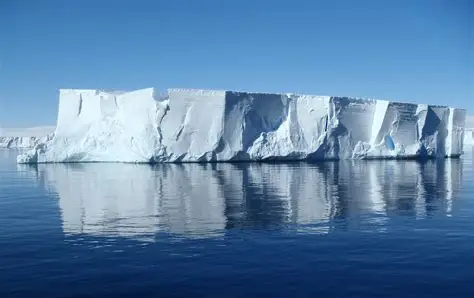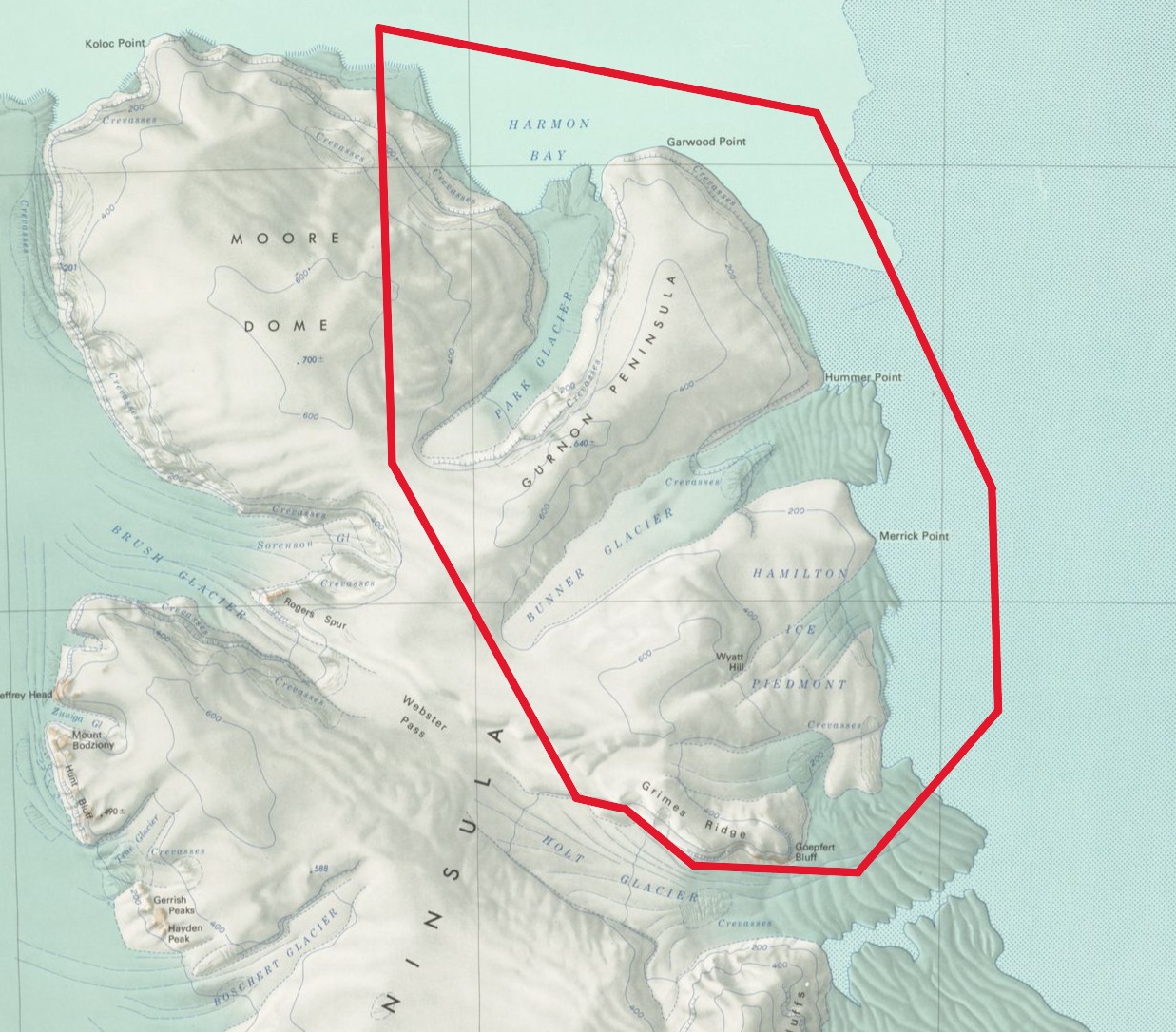Hamilton Ice Piedmont Conservation Area
Hamilton Ice Piedmont Conservation Area (74°30′S 110°18′W) is a protected area of Westarctica created to preserve a number of landscape features. It was created via Royal Decree on 8 August 2025 by Grand Duke Travis. It falls under the oversight of the Westarctican Parks Service.
History
A 490 ha site on fast ice east of the headland of Hummer Point on Gurnon Peninsula has been designated an Important Bird Area (IBA) by BirdLife International because it supports a breeding colony of about 9,500 emperor penguins, estimated from 2009 satellite images.
Conservans Protectorem
Those nobles whose titles were named for features within the memorial when it was established were afforded the additional honorific Conservans Protectorem to use in conjunction with said title. Hamilton Ice Piedmont Conservation Area granted that honorific to the following:
- Duke of the Bear Peninsula
- Duke of Hamilton
- Count of Gurnon
- Count of Moore
- Baron of Garwood
- Baron of Merrick
Conservation
Hamilton Ice Piedmont Conservation Area's roughly 366,175 acres (1,481 square kilometers) is protected under category III (natural monument or feature) of the International Union for Conservation of Nature. These protections mean that conservation efforts are primarily aimed at the preservation of the geologic and natural landscape. Although a slightly lesser concern, efforts are also made to protect biodiversity found within its boundaries.
In addition to protecting one of Westarctica's two ice piedmonts, this area also protects two glaciers, coastal waters, and the nation's largest colony of emperor penguins.
Features
The conservation area envelops a large portion of the Bear Peninsula and is one of the more geographically diverse protected areas in the Parks Service.
Key locations
- Bunner Glacier (74° 28'S 110° 40'W) is a glacier in the northeast part of Bear Peninsula, flowing to the sea along the southeast side of Gurnon Peninsula. It was named by the Advisory Committee on Antarctic Names in honor of Sergeant Donald R. Bunner, a member of the U.S. Army Aviation Detachment in Antarctica during U.S. Navy Operation Deepfreeze 1965 and 1966.
- Garwood Point (74°14′S 110°36′W) is a point marking the northern extremity of Gurnon Peninsula, a northeast arm of the Bear Peninsula. It was named by the Advisory Committee on Antarctic Names in honor of James W. Garwood, a U.S. Navy metalsmith, who served as crew chief at Williams Field, McMurdo Sound, and in Christchurch, New Zealand, as well as maintenance shop supervisor in eight Operation Deep Freeze deployments.
- Goepfert Bluff (74°38′S 110°19′W) is a bluff at the east end of Grimes Ridge, Bear Peninsula. It was named by the Advisory Committee on Antarctic Names in 1977 after Lieutenant Eric R. Goepfert, U.S. Navy, officer in charge of the U.S. Naval Support Force, Antarctica, winter detachment at McMurdo Station, 1976.
- Grimes Ridge (74°38′S 110°30′W) is a high, mostly ice-covered ridge at the north side of Holt Glacier on Bear Peninsula. It was named by the Advisory Committee on Antarctic Names after Captain E.W. Grimes, a member of the U.S. Army Aviation Detachment that provided Antarctic support during U.S. Navy Operation Deep Freeze 1966.
- Gurnon Peninsula (74°22′S 110°35′W) is a completely ice-covered peninsula about 10 nautical miles (20 km) long, between Park Glacier and Bunner Glacier in the northeast part of the Bear Peninsula. It was named by the Advisory Committee on Antarctic Names in honor of Lieutenant P.J. Gurnon, U.S. Navy, a Lockheed Hercules aircraft commander in Antarctica during Operation Deep Freeze 1965–67.
- Hamilton Ice Piedmont (74°30′S 110°18′W) is an ice piedmont, 8 nautical miles (15 km; 9.2 mi) wide, to the east of Wyatt Hill on the Bear Peninsula. It was named in 1977 by US-ACAN after Robert Hamilton, a meteorologist from the University of California, Davis who served as the USARP Station Scientific Leader at South Pole Station during the winter of 1975.
- Harmon Bay (74°15′S 110°52′W) is an embayment at the north end of the Bear Peninsula, about 7 nautical miles (13 km) wide, defined by the northeast shore of Moore Dome, the terminus of Park Glacier and the northwest end of the Gurnon Peninsula. It was named by the Advisory Committee on Antarctic Names after Commander Robert H. Harmon, Executive Officer on the USCGC Burton Island (WAGB-283) during U.S. Navy Operation Deep Freeze in 1969.
- Hummer Point (74°37′S 110°25′W) is the eastern point of the ice-covered Gurnon Peninsula, and is the location of Westarctica's largest emperor penguin colony. It was named by the Advisory Committee on Antarctic Names in 1977 after Dr. Michael G. Hummer.
- Merrick Point (74°28′S 110°9′W) is an ice-covered point on the east side of Hamilton Ice Piedmont on the eastern edge of the Bear Peninsula. It was named by the Advisory Committee on Antarctic Names in 1977 after Dale Merrick of Stanford University. Merrick was an upper atmosphere researcher and Station Scientific Leader at Siple Station during the over-winter of the 1975 season.
- Moore Dome (74°20′S 111°20′W) is an ice dome, circular in plan and 15 nautical miles (28 km) in extent, rising to 700 meters (2,300 ft) and forming the northwest portion of the Bear Peninsula. Koloc Point is at the northern extremity of the coast of the dome. It was named by the Advisory Committee on Antarctic Names in 1977 after Captain Robert G. Moore, USCG, Commanding Officer of USCGC Burton Island. Only the eastern portion of the dome is protected by the conservation area.
- Park Glacier (74°20′S 110°38′) is a glacier located on the northern part of the Bear Peninsula of Westarctica. It flows to the sea along the west side of the Gurnon Peninsula. It is named for Chung G. Park, who worked as an ionosphere physics researcher at Byrd Station in 1966.
- Wyatt Hill (74°32′S 110°27′W) is a small ice-covered hill rising to about 500 m at the west side of Hamilton Ice Piedmont, Bear Peninsula. It was named by Advisory Committee on Antarctic Names (US-ACAN) after Joseph T. Wyatt, electrical engineer, Lockheed-Georgia Company, a member of the aircraft recovery team at Dome Charlie in 1975-76 and 1976–77, which accomplished the repair and recovery of three LC-130 Hercules aircraft damaged there during January and November 1975.

